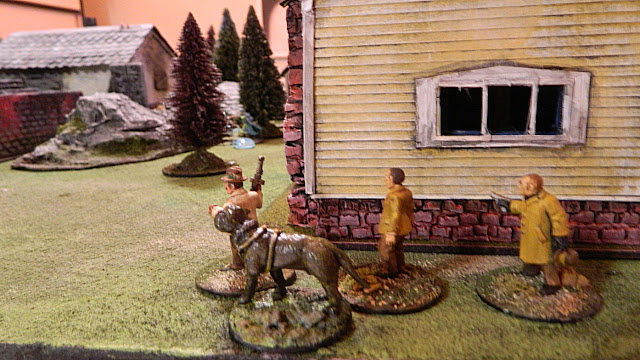 It's a new year and I've got more information regarding the progress of MEST 2.x. I notice that it has been since 2013 when I started this effort, and it gets closer as time goes on. I hope to finish this one day.
It's a new year and I've got more information regarding the progress of MEST 2.x. I notice that it has been since 2013 when I started this effort, and it gets closer as time goes on. I hope to finish this one day.These are notes regarding the draft file at https://drive.google.com/file/d/0Bw91639XP2nbemNLaE1Ib3N4b28/view?usp=sharing
BASIC GAME
This area's core rules are fairly stable, but I'm always trying to clarify with more examples and simpler phrasing. Hard work. Many of the elements such as Movement or Combat could be made simpler and those need the most work since they'll be used the most frequently.
ARCHETYPES
I've expanded the section on Archetypes to better define what they mean (page 8). Commons are now just the Average, Untrained, Veteran, and Elite archetypes. Specialist archetypes are those such as Acrobat, Leader, Martialist, Mystic, Hero, etc. I tried to clarify where possible the various entry types.- Untrained - One addition is the Untrained type which is basically civilians because the Average type should represent the typical combatant.
- Healer - Added Healer archetype as part of Commons and Variant Commons
- I've also made Variant Archetypes more clearly defined, and state that most modern genre characters would be of the Average Variants types; basically all stats are 2 and then they get a single trait.
PURCHASING CHARACTERS
I've better defined the use of Available Hands (page 11).- This can still get tricky, and I haven't yet figured out what to do with four-armed characters such as Tharks/Warhoons ... which I'll probably worry about once I get the VSF genre more completed.
PLAYING THE GAME
I've expanded this section to make it more clear what the sequence of play is (page 17).- One key addition is the inclusion of End-game Trigger as the mechanism for variable game-length. This now serves as a core system rule.
- This also prepares the rules set for use of the optional Resource cards which make reference to End-game triggers. See page 19.
ACTIONS
I've made two additions here which I think improve the game (page 20).- Consecutive Attempts - +1 Modifier die, up to +2 Modifier dice, for repeating an action against the same target.
- Move - A character's MOV attribute (normally a '2') determines how many facing changes are allowed during movement. Movement segments are all straight lines.
REACT ACTIONS
I've clarified that this is usually what happens when a character is in Wait status (page 23).- However, in order to reduce in-game exploits I make it clear that Attentive Ordered characters may react to Distracted models with lower REF. This increases the worth of REF as well.
- I am still considering "Infinity the Game"-style automatic reacts for target models of Range attacks to automatically seek Cover. At this time, this is defined as a standard Passive Player Option.
BONUS ACTIONS
I've clarified how often Bonus Actions can be used (page 28).- Also, I've introduced clarifications for Circle, Push-back, Pull-back, Reversal; must be in base-contact unless discard a cascade from the successful Combat Test.
- Furthermore, I've introduced SIZ + STR for Push-back and Pull-back to make it easier for bigger models to move smaller models around, and smaller models need more cascades.
DAMAGE & MORALE
I changed the way we do Wounds. If Damage is greater than existing Wounds, then Wounds equal Damage. Otherwise just increase +1 Wound. This makes bigger characters last longer in combat (page 31).MORALE, FEAR, and RALLY TESTS
I've clarified how often Fear tests are resolved (page 32).- It's basically once per Turn. I discovered that archetypes such as the Gryffon or Gorgon with their Fear 5 affected too many characters at once.
- I did some analysis and ... not just for MEST but many TTWG with "Fear" or "Terror" have the same problem of just how effective and annoying that trait could be. Worst case scenario is about 1 target model per Fear X ... so Fear 5 could affect 5 target models per Action!
ADVANCED GAME
This section has been slowly expanding. I'm still trying out Champions, Campaigns, and the Magic System. I've got the rules ... just not happy with the rules overload because they'd be sub-systems.
RATE-of-FIRE, SUPPRESSION, FIRE-LANE
I clarified these a bit more, to make it precise. (page 33).- ROF - "Rate-of-Fire" has a Basic Game version, and an Advanced Game version.
- Suppression - This is a head-ache. Necessary but I think could still be worded simpler.
- Fire-lane - This is another head-ache. I'll need to set up a large-scale session to debug it.
FLIGHT
I added this to handle flying characters. Seems to work OK during play-tests (page 35).FANTASTIC ITEMS
This is a new classified system. Items (Weapons, Armor, Equipment) can be given a classifier keyword which prefixes it such as "Psychic", "Arcane", or "Etheric" to generally alter how it is used.I have been using this for "Psychic" weapons. It seems to work fine, and there's no BP difference (page 36).
For example, a Psychic Shotgun or Psychic Light Armor have the same effects as a physical Shotgun or Light Armor but the character does not need to be sculpted with them.

























